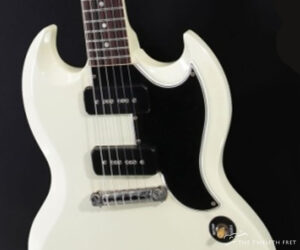The 2007 Gibson SG Special VOS replicates the 1961 style, with a pair of P90 pickups and Classic White finish. Currently this model is offered as the 1963 SG Special Classic White Ultra Light Aged. Like the SG itself, the SG Special originated as a Les Paul model, officially renamed in late 1963 at the end of Les Paul’s endorsement contract
Gibson
The Gibson G-00 appeared in 2021 and hearkens back to classic entry-level models like the LG-0. It also adds a ‘Player Port’ on the upper bass bout that directs sound to the player. The G-00, now discontinued, was part of the ‘Generation’ series, which all feature the secondary sound hole.
This instrument has sold
MORE →Here we’re looking at a Gibson Style A ‘Snakehead’ Black-top mandolin in A-1 trim from 1927 in overall good and largely original condition. The ‘Snakehead’ term refers to the tapered headstock, an innovation by Lloyd Loar that reduced string friction at the nut. ‘Snakehead’ models were built from 1923 to 1927.
Shown here is an original condition Gibson SG Standard with optional Bigsby from 1973, in Walnut finish and originally sold at Mamelok LTD in Manchester, England, which closed in 1993. The Gibson SG Standard launched with the SG name in 1963, but really first appeared in 1961 as a radical redesign of the Les Paul model.
The Cromwell G-4 archtop guitar was built by Gibson from 1935 to 1939 and sold to various retailers and catalog distributors. Inside this guitar, visible through the bass F-hole is a well-preserved yellow label reading ‘New York Band Instrument Company’ indicating that it was sold by that company, at the time a large music store in New York City, but gone by 1950.
Seen here is a Gibson L-4C cutaway archtop acoustic guitar with an original DeArmond Rhythm Chief 1100 pickup with its ‘Monkey on a Stick’ mount. This fine vintage guitar very much looks the part, and it plays well. The 16-inch wide Gibson L-4C was introduced in 1949 and came to replace the non-cutaway L-4. That model first appeared in 1912 as an oval-hole archtop, with F-holes becoming available in 1935 and finally discontinued in 1956.






